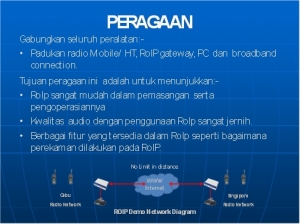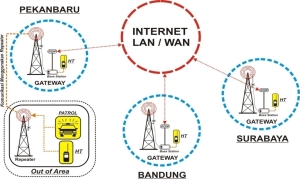Pada tahun 1980 sd 1990.. adalah masa2 kejayaan dari radio vhf atau uhf.
Dengan terbatasnya jarak jangkau, membuat pengguna merasa tertantang
untuk meningkatkan jarak jangkau radio pada band VHF / UHF tsb.
Maka dibuat berbagai macam bentuk,jenis directional antenna ,sebut saja seperti Multi Beam, ZL, delta Loop, qubical quad dll.
Agar jaraknya lebih jauh lagi yagi antenna tsb dibuat puluhan
element, kemudian ditenggerkan pada tower hingga pada ketinggian 30
meter, ditambah rotator antenna, booster dll.
Kemudian dibangun pula station repeater,serta berbagai macam
assesories lainnya yang harganya jutaan rupiah demi untuk mendapat
kepuasan pengguna radio.
Namun tetap saja jangkauan tsb tidak terlalu jauh , terjauh pun hanya sekitar 100 km ..
Untuk menambah jangkauan repeater tsb, repeater diberi tambahan link,
untuk mencover P Jawa hingga ke Bali, hamper ditiap kota besar di
buatkan repeater ditambahkan link unitnya.
Dengan repeater plus link ini ,memang dapat mengatasi jarak jangkau
walau banyak sekali halangannya sepert delay yang lama belum lagi bila
salah satu radio link rusak , maka terputus pula komunikasi tsb,
Adalah teman2 dari Orari yang terus menerus tanpa lelah mengadakan percobaan2 khususnya di bidang komunikasi radio.
Untuk komunikasi radio jarak jauh semisal antar pulau, pernah pula
penulis menggandeng radio VHF untuk kemudian di link ke SSB, memang
hasilnya cukup baik, namun terlalu banyak kendala yang dihadapi , ssb
sangat tergantung dengan cuaca dan waktu, sehingga belumlah effektif
menggunakan cross band repeater VHF to HF..
Sejak 2-3 tahun yang lalu telah muncul dan mulai populer radio yang digabungkan dengan jaringan internet.
Dahulu dikenal istilah VOiP ( Voice over internet protocol ) maka
istilah yang menggandengkan radio ke internet di istilahkan “ ROiP ” (
Radio Over Internet Protocol)
Apakah RoIP itu ?
RoIP adalah singkatan dari “ Radio Over Internet Protocol “ dimana penyampaian informasi yang berasal dari radio komunikasi ( two way radio) disebar luaskan melalui jaringan internet..
Roip adalah teknologi yang merubah informasi audio analog menjadi data dalam bentuk digital yang kemudian disisipkan ke jarring internet , lan, wan.
Analog audio tsb di rubah (encoding) dengan sinyal standar code spt G 711, atau G 723 dll.
Data digital ini kemudian dikirim ke UDP (User Datagram Protokol ) atauTCP ( Transfer Conection Protocol ) atau transport layer protokol sejenis untuk dikirimkan ke IP Network istilah ini lazim disebut TCP/IP
Pada sisi penerima, radio penerima merubah sinyal yang diterimanya di kembali kan ke bentuk sinyal audio analog.
Perlengkapan untuk ROiP :
1. Handytransceiver
2. Base station sbg transceiver
3. Interface / ROiP Gateway
4. Power supply
5. Antenna sbg penerima dan memancar.
6. Saluran transmisi ( coaxial cable)
7. Jaringan internet dg bandwidth yg kecil. ( min up load 20 KB )
Apakah RoIP itu ?
RoIP adalah singkatan dari “ Radio Over Internet Protocol “ dimana penyampaian informasi yang berasal dari radio komunikasi ( two way radio) disebar luaskan melalui jaringan internet..
Roip adalah teknologi yang merubah informasi audio analog menjadi data dalam bentuk digital yang kemudian disisipkan ke jarring internet , lan, wan.
Analog audio tsb di rubah (encoding) dengan sinyal standar code spt G 711, atau G 723 dll.
Data digital ini kemudian dikirim ke UDP (User Datagram Protokol ) atauTCP ( Transfer Conection Protocol ) atau transport layer protokol sejenis untuk dikirimkan ke IP Network istilah ini lazim disebut TCP/IP
Pada sisi penerima, radio penerima merubah sinyal yang diterimanya di kembali kan ke bentuk sinyal audio analog.
Perlengkapan untuk ROiP :
1. Handytransceiver
2. Base station sbg transceiver
3. Interface / ROiP Gateway
4. Power supply
5. Antenna sbg penerima dan memancar.
6. Saluran transmisi ( coaxial cable)
7. Jaringan internet dg bandwidth yg kecil. ( min up load 20 KB )
KEUNTUNGAN MENGGUNAKAN RoIP
RoIP menyatukan jaringan komunikasi dengan mudah.
Jaringan radio ditempat berbeda bahkan dengan band frequency berbeda dapat dipadukan menjadi suatu sistem jaringan komunikasi yang terpadu
Roip dapat mendukung sistem komunikasi suara live hingga 30 wilayah secara bersamaan.
Roip bekerja dengan standar jaringan LAN/WAN .
Roip dapat dipadukan pada radio mobile, atau HT yang memiliki fasilitas PTT,COR,Audio out/in
Roip dirancang untuk bekerja pada lingkungan kerja yang sulit serta tdk dibutuhkan computer di lapangan
Kwalitas audio yang jernih ( syarat bandwidth / kecepatan min 20 KB utk up load terpenuhi )
RoIP menyatukan jaringan komunikasi dengan mudah.
Jaringan radio ditempat berbeda bahkan dengan band frequency berbeda dapat dipadukan menjadi suatu sistem jaringan komunikasi yang terpadu
Roip dapat mendukung sistem komunikasi suara live hingga 30 wilayah secara bersamaan.
Roip bekerja dengan standar jaringan LAN/WAN .
Roip dapat dipadukan pada radio mobile, atau HT yang memiliki fasilitas PTT,COR,Audio out/in
Roip dirancang untuk bekerja pada lingkungan kerja yang sulit serta tdk dibutuhkan computer di lapangan
Kwalitas audio yang jernih ( syarat bandwidth / kecepatan min 20 KB utk up load terpenuhi )
Bagaimana cara kerja RoIP ?
Aplikasi lain dari RoIP
Menambah jangkauan radio ditempat yang sulit (blind spot) spt gedung2
Menggabungkan sistem radio komunikasi untuk keadaan gawat darurat,kepolisian,ambulance ,sar dll.
Menghubungkan repeater bergerak untuk pengawalan presiden,yang menggunakan jarigan 3G atu Visat.
Menggabungkan sistem radio komunikasi untuk keadaan gawat darurat,kepolisian,ambulance ,sar dll.
Menghubungkan repeater bergerak untuk pengawalan presiden,yang menggunakan jarigan 3G atu Visat.
Yang sering terjadi Dilapangan
Terbatasnya Jarak jangkau dari ht menuju radio gateway :
Mengatasinya dengan menggunakan antenna yang baik cocok dengan frequncy kerja (match)
Menambah ketinggian antenna penerima sehingga jarak penerimaan serta pancaran akan bertambah luas, namun dengan memeperhatikan kondisi2 spt : gunakan radio yang baik, dalam artian radio tsb harus sensitif serta mempunyai selektifitas yang baik pula, radio jenis ini biasanya tidak dimiliki oleh radio type amateur , kebanyakan radio jenis ini , bila ditinggikan antennanya maka akan gangguan penerimaan akan bertambah , spt splatter,dan noise2 lainnya.
Hal ini dapat diatasi dengan menambahkan sebuah filter.
Atau kita dapat menggunakan radio type komersil ( commercial type) radio jenis ini memilik bandwidth yang tdk terlalu lebar,sehingga filtering nya jauh lebih baik
Menambah jarak jangkauan dapat juga dengan menambahkan sebuah repeater sehingga jarak jangkau nya bertambah sesuai coverage area repeater tsb.
Membagi area penerimaan jadi beberapa area.
Kita dapt menambahkan beberapa penerima gateway ditiap wilayah yang akan kita tentukan..
Misalkan untuk wilayah jakarta,tentunya kita tidak mungkin membuat satu bh gateway saja maka agar dapat mendapat cakupan yang luas, maka kita harus membagi kota tsb spt : jakarta selatan, jakarta pusat, jakarta utara,jakarta barat dan timur dsb.
Nah radio gateway kita tempatkan ditiap wilayah tsb. Seihingga bila ada ht atau radio yang bergerak, dapat berpindah dengan memilih frequency radio gateway terdekat agar mendapatkan signal pancar ataupun terima yang baik.
Kelemahan sistim ini, adalah kita harus menggunakan lebih dari satu kanal frequency , serta kita harus memiutar kanal frekwensi sesuai dengan frekwensi kerja wilayah tsb.
Terbatasnya Jarak jangkau dari ht menuju radio gateway :
Mengatasinya dengan menggunakan antenna yang baik cocok dengan frequncy kerja (match)
Menambah ketinggian antenna penerima sehingga jarak penerimaan serta pancaran akan bertambah luas, namun dengan memeperhatikan kondisi2 spt : gunakan radio yang baik, dalam artian radio tsb harus sensitif serta mempunyai selektifitas yang baik pula, radio jenis ini biasanya tidak dimiliki oleh radio type amateur , kebanyakan radio jenis ini , bila ditinggikan antennanya maka akan gangguan penerimaan akan bertambah , spt splatter,dan noise2 lainnya.
Hal ini dapat diatasi dengan menambahkan sebuah filter.
Atau kita dapat menggunakan radio type komersil ( commercial type) radio jenis ini memilik bandwidth yang tdk terlalu lebar,sehingga filtering nya jauh lebih baik
Menambah jarak jangkauan dapat juga dengan menambahkan sebuah repeater sehingga jarak jangkau nya bertambah sesuai coverage area repeater tsb.
Membagi area penerimaan jadi beberapa area.
Kita dapt menambahkan beberapa penerima gateway ditiap wilayah yang akan kita tentukan..
Misalkan untuk wilayah jakarta,tentunya kita tidak mungkin membuat satu bh gateway saja maka agar dapat mendapat cakupan yang luas, maka kita harus membagi kota tsb spt : jakarta selatan, jakarta pusat, jakarta utara,jakarta barat dan timur dsb.
Nah radio gateway kita tempatkan ditiap wilayah tsb. Seihingga bila ada ht atau radio yang bergerak, dapat berpindah dengan memilih frequency radio gateway terdekat agar mendapatkan signal pancar ataupun terima yang baik.
Kelemahan sistim ini, adalah kita harus menggunakan lebih dari satu kanal frequency , serta kita harus memiutar kanal frekwensi sesuai dengan frekwensi kerja wilayah tsb.
Peralatan yang digunakan :
HT sebagai radio yang bergerak.
Radio base station sebagai stasiun tetap
RoIP Interface gateway.
1 station lengkap.
Blok diagram lengkap radio komuniksai melalui internet
Pada blok diagaram diatas diibaratkan kita memiliki beberapa lokasi yang ingin dapat dikoneksikan.
Masing 2 Perlengkapan yang harus disiapkan : Bandung , Pekanbaru, Surabaya sbb :
1.sebuah radio base station ( transceiver) yang berfungsi sebagai penerima dan
memancar kembali.
2. Radio Gateway ( ROIP INTERFACE )
3. Handytransceiver di area yang akan dicover oleh radio tsb
4. Antenna base station.
5.saluran transmisi, pwr supply dan lalinnya.
Contoh Alur Kerja Panggilan : misalkan dari Bandung ke Surabaya.
Bandung memanggil dengan menekan PTT HT di Bandung area, pancarannya
diterima oleh radio base st Bandung,. Segala informasi yang dalam
bentuk audio analog akan di masuukkan ke ROIP Interface, yang
selanjutnya akan di ubah dlm bentuk digital serta diberi code tertentu.
Selanjutnya informasi digital ini akan di sisipkan ke jaringan internet untuk disebarkan luaskan.
Sinyal informasi ini hanya akan dapat diterima oleh radio yang berkode sama dalam networknya..
Dengan kata lain Sinyal informasi ini tak dapat didengar oleh radio
lain yang mungkin pula ada dalam jaringan bila kode tdk disamakan..
Radio Dengan code yang sama akan mengambil sinyal digital ini untuk
kemudian di ubah kembali ke bentuk analog lalu sinyal tsb diolah oleh
radio kebentuk audio yang selanjutnya dipancarkan oleh base station
Pekanbaru dan Surabaya shg informasi ( dari Bandung ) dapat
didengar di radio HT Pekanbaru / Surabaya ..
Proses ini akan terulang secara kebalikan bila panggilan datang dari wilayah Surabaya ataupun dari Pekanbaru..
BLANK AREA..
Bila ada daerah yang blank spot, sedangkan komunikasi ingin mencapai
daerah tersebut, maka hal ini dapat dipecahkan dengan cara :
1. Menambah 1 station gateway.. namun dengan syarat ada fasilitas internet
Bagaimana bila tidak tersedia fasilitas internet missal : bila stasiunnya bergerak ( mobile).
Maka hal ini dapat diatasi dengan menambahkan sebuah repeater ke wilayah blank spot tsb ( out of area)..
ALUR KERJA PANGGILAN ROIP VIA REPEATER : Pangilan dari Ht atau mobile station masuk ke repeater..
Komunikasi ini spt komunikasi biasa menggunakan repeater, hanya
sekarang pancaran repeater diterima oleh base station yang mana pancaran
ini diambil informasinya untuk diubah dan di sisipkan ke jaringan
internet.
Saran : Karena menggunakan repeater, maka kemungkinan seluruh
informasi /pembicaraan dapat didengar oleh pihak lain, sehingga
dianjurkan untuk menggunakan scramble , namun ini akan menambah biaya
pengadaan..
Sejujurnya kamipun belum pernah mencoba radio yang berscrambler
digunakan / untuk jaringan ini, shg blm dapat memberikan penilaian
apakah adakah penurunan kwalitas audio atau bahkan tdk dapat dilakukan
sama sekali.
Tetapi bila ditinjau secara umum, seharusnya proses dapat berjalan
sama menggingat keluaran dari base station telah di descramble terlebih
dahulu oleh radio penerima ( base station )
Perbandingan penggunaan : ROiP dengan SSB.
ROIP SSB
| Hasil suara sangat bersih,tdk terganggu cuaca | Suara kurang bersih,terganggu cuaca |
| Jangkauan tdk terbatas | Jangkauan tdk terbatas tergantung antenna |
| Mahal | Lebih murah dan lebih sederhana |
| Dapat digunakan selama 24 jam | Hanya jam2 tertentu dan pada frequency tertentu |
| Tergantung dari kwalitas stabilitas internet | Dapat berdiri sendiri |
| Untuk jarak jauh ada delay 1-2 detik | Tidak ada delay |
| Perlu latihan cara berkomunikasi dg procedure yang terstandarkan agar komunikasi tdk tumpang tindih,terutama yang blm pernah. |
Sumber: http://rielmotorola.wordpress.com/















